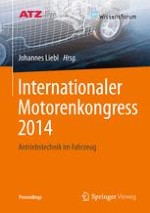2014 | OriginalPaper | Buchkapitel
Potential of the combustion engine to reach future CO2 emissions
verfasst von : Stefan Pischinger, Prof. Dr., Benedikt Heuser, Dipl. -Wirt. -Ing.
Erschienen in: Internationaler Motorenkongress 2014
Verlag: Springer Fachmedien Wiesbaden
Aktivieren Sie unsere intelligente Suche, um passende Fachinhalte oder Patente zu finden.
Wählen Sie Textabschnitte aus um mit Künstlicher Intelligenz passenden Patente zu finden. powered by
Markieren Sie Textabschnitte, um KI-gestützt weitere passende Inhalte zu finden. powered by
Within the upcoming emission legislations, engine exhaust pollutants and the fuel consumption respectively CO
2
emissions will become more stringent worldwide. Since there is typically a trade-off between reducing tailpipe pollutants and the car’s fuel efficiency meeting both limits simultaneously will be challenging. However, the CO
2
- saving potential of both gasoline and diesel engines is not outbid yet but further improving the engines efficiency will require an accurate balancing of their benefits and costs.
For all types of engines thermal management and friction reduction will be in the main focus for all segments. Efficient exhaust gas aftertreatment systems will be a key measure for reducing CO
2
-emissions and pollutants particularly for diesel engines. Additionally, engine hardware measures as e.g. variable valve timing and valve lift will be introduced and combined high- and low-pressure exhaust gas recirculation will be used more frequently. Another potential for engine optimization is in coupling of different technologies, e.g. 2-stage turbo-charging in combination with a gearbox featuring a wider gear spread for load point shift into more favourable regions. For spark ignited engines there will be an increase of engines equipped with valve train variability in order to utilize Miller- and Atkinson cycles for de-throttling the engine. At high and full load operation recirculation of cooled exhaust gas can reduce the knock tendency giving the potential to further increase the compression ratio and thus the thermal efficiency at part load operation. By utilizing a variable compression ratio high efficiency at part load can be achieved while simultaneously not sacrificing power output at full load. Further, this technology enables to fully exploit the potential of fuels with high knock resistance and stretch the operational area of unconventional combustion processes as e.g. controlled auto ignition. For both types of engines different fuels help meeting the emission limits as well. E.g., compressed natural gas (CNG) is an interesting fuel candidate for SI engines since it features a very high knock resistance on the one hand and a higher hydrogen to carbon ratio on the other hand.
